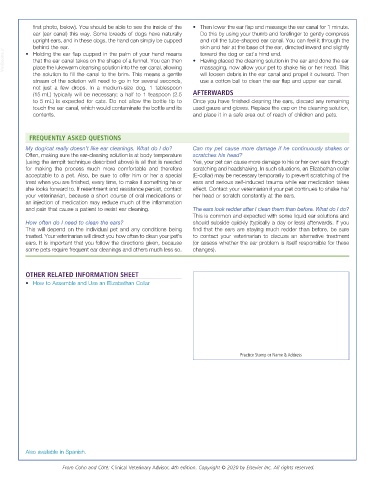Page 3184 - Cote clinical veterinary advisor dogs and cats 4th
P. 3184
first photo, below). You should be able to see the inside of the • Then lower the ear flap and massage the ear canal for 1 minute.
ear (ear canal) this way. Some breeds of dogs have naturally Do this by using your thumb and forefinger to gently compress
upright ears, and in these dogs, the hand can simply be cupped and roll the tube-shaped ear canal. You can feel it through the
behind the ear. skin and hair at the base of the ear, directed inward and slightly
VetBooks.ir that the ear canal takes on the shape of a funnel. You can then • Having placed the cleaning solution in the ear and done the ear
• Holding the ear flap cupped in the palm of your hand means
toward the dog or cat’s hind end.
massaging, now allow your pet to shake his or her head. This
place the lukewarm cleansing solution into the ear canal, allowing
the solution to fill the canal to the brim. This means a gentle will loosen debris in the ear canal and propel it outward. Then
stream of the solution will need to go in for several seconds, use a cotton ball to clean the ear flap and upper ear canal.
not just a few drops. In a medium-size dog, 1 tablespoon
(15 mL) typically will be necessary; a half to 1 teaspoon (2.5 AFTERWARDS
to 5 mL) is expected for cats. Do not allow the bottle tip to Once you have finished cleaning the ears, discard any remaining
touch the ear canal, which would contaminate the bottle and its used gauze and gloves. Replace the cap on the cleaning solution,
contents. and place it in a safe area out of reach of children and pets.
FREQUENTLY ASKED QUESTIONS
My dog/cat really doesn’t like ear cleanings. What do I do? Can my pet cause more damage if he continuously shakes or
Often, making sure the ear-cleaning solution is at body temperature scratches his head?
(using the armpit technique described above) is all that is needed Yes, your pet can cause more damage to his or her own ears through
for making the process much more comfortable and therefore scratching and headshaking. In such situations, an Elizabethan collar
acceptable to a pet. Also, be sure to offer him or her a special (E-collar) may be necessary temporarily to prevent scratching of the
treat when you are finished, every time, to make it something he or ears and serious self-induced trauma while ear medication takes
she looks forward to. If resentment and resistance persist, contact effect. Contact your veterinarian if your pet continues to shake his/
your veterinarian, because a short course of oral medications or her head or scratch constantly at the ears.
an injection of medication may reduce much of the inflammation
and pain that cause a patient to resist ear cleaning. The ears look redder after I clean them than before. What do I do?
This is common and expected with some liquid ear solutions and
How often do I need to clean the ears? should subside quickly (typically a day or less) afterwards. If you
This will depend on the individual pet and any conditions being find that the ears are staying much redder than before, be sure
treated. Your veterinarian will direct you how often to clean your pet’s to contact your veterinarian to discuss an alternative treatment
ears. It is important that you follow the directions given, because (or assess whether the ear problem is itself responsible for these
some pets require frequent ear cleanings and others much less so. changes).
OTHER RELATED INFORMATION SHEET
• How to Assemble and Use an Elizabethan Collar
Practice Stamp or Name & Address
Also available in Spanish.
From Cohn and Côté: Clinical Veterinary Advisor, 4th edition. Copyright © 2020 by Elsevier Inc. All rights reserved.

